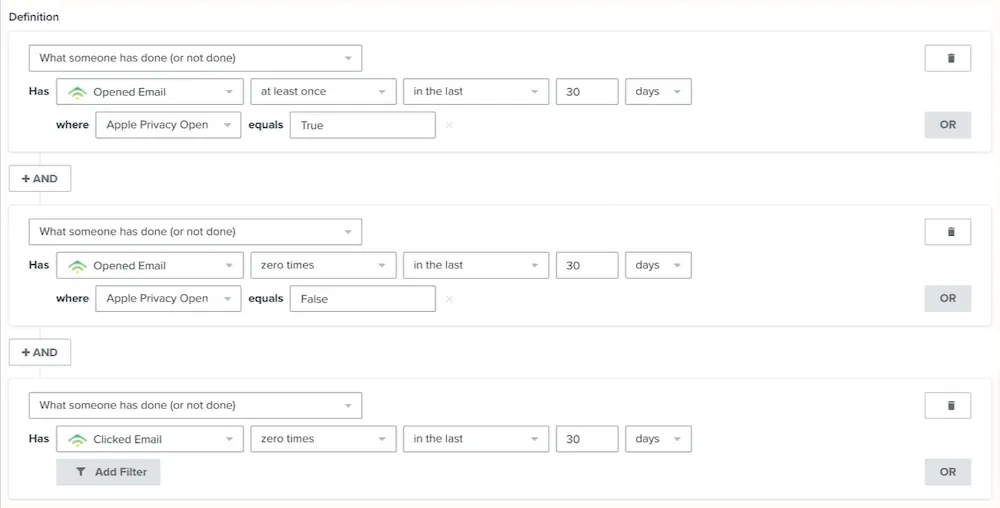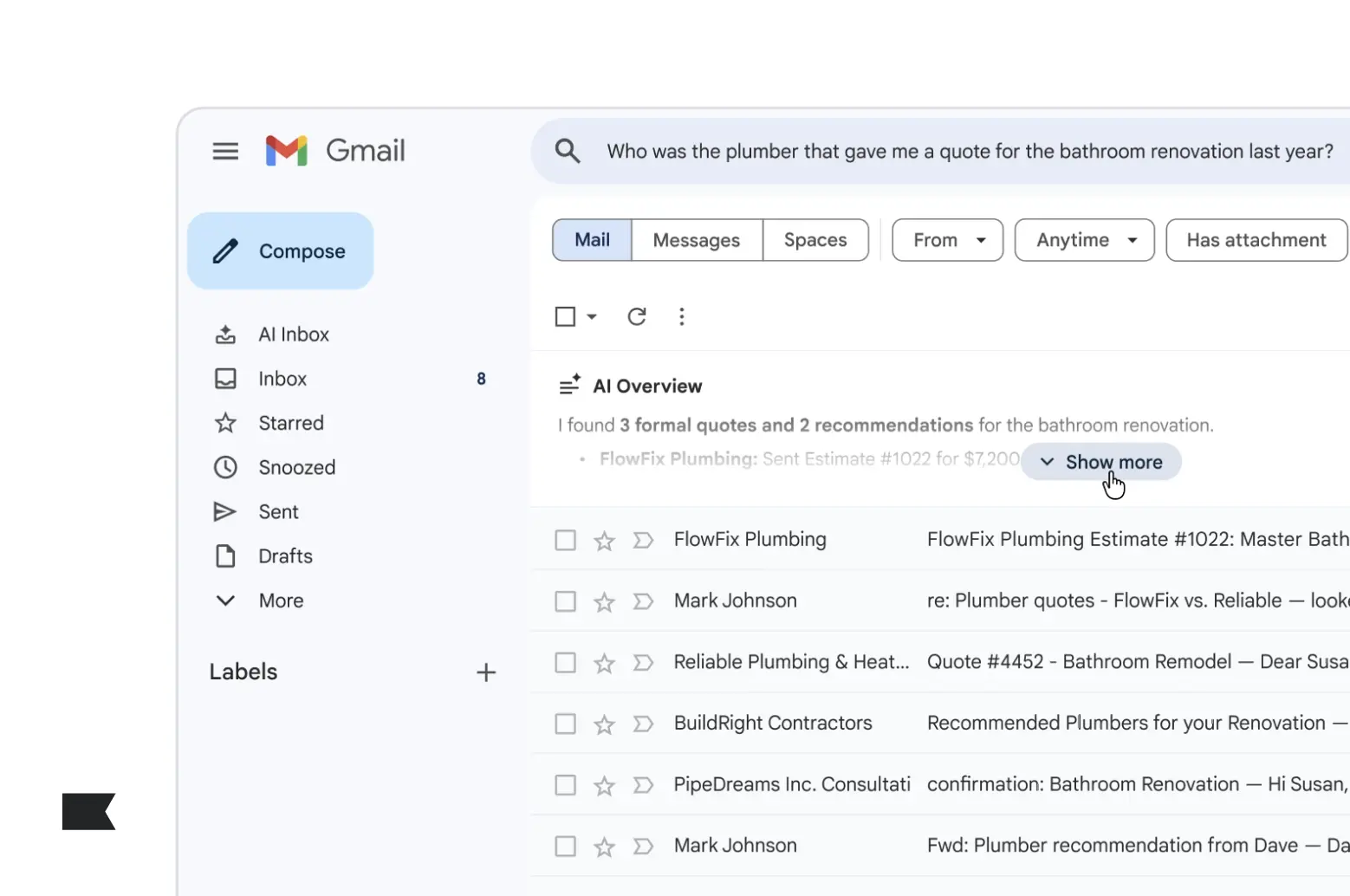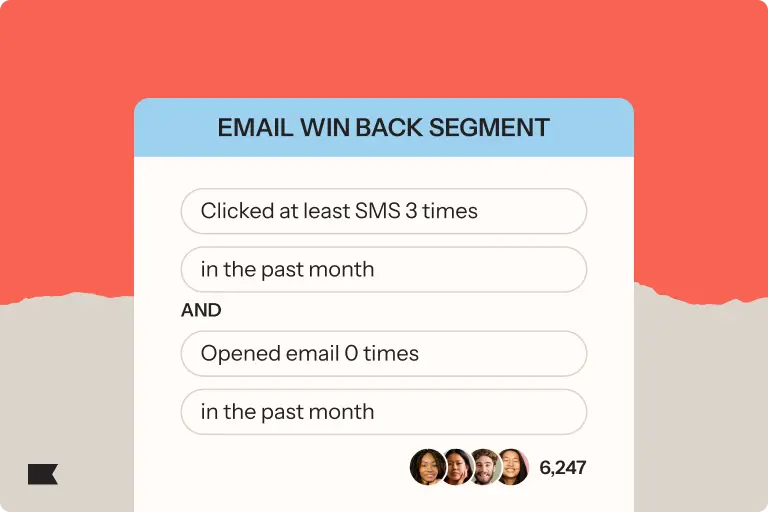Email open rates are (mostly) irrelevant. Here are 7 ways you can—and should—still use open rate data.

Email open rates have been a fraught metric since Apple’s iOS 15 rolled out in late 2021.
“For any user with Apple Mail Privacy Protection (MPP) enabled, Apple opens emails and pre-downloads content to their servers,” says Mindy Regnell, head of market intelligence at Klaviyo.
“This makes emails look as though they were opened by the subscriber even if they never saw it,” Regnell explains. “A brand’s open rates might seem high, but that’s because Apple’s process counts as an open and brands can’t tell if their subscribers are actually interacting with them at all.”
A brand’s open rates might seem high, but that’s because Apple’s process counts as an open—and brands can’t tell if their subscribers are actually interacting with them at all.
If you get creative, you can still get relatively reliable open rate metrics—by excluding machine opens, for instance. But the days of a true percentage to guide you on your sending practices strategy are likely over.
While this may not be news to you, the bigger news is that open rate data is still a metric worth looking at.
How iOS 15 affected open rates—and your brand’s strategy
The biggest danger with iOS 15 and the way it inflates open rates is that it gives brands a false sense of strong performance. And when talking to prospects through my agency, Zettler Digital, I see this kind of thing far too often.
Sending “batch and blast” campaigns—where recipients make up a wide range of total potential recipients in an account—can generally have a negative impact on a brand’s ability to reach user inboxes, since the content isn’t personalized.
Then, Apple is “opening” each email for any user who has enabled Apple MPP—whether or not it even catches the subscriber’s eye in the inbox.
The next thing you know, brands think sending the same email to 25K people yielded a 50% open rate. So, they keep on sending, investing more into getting their marketing messages in front of those subscribers.
After high-fives die down, they might be left wondering why their click rates and placed order rates are so low. Well, it’s because the open rate Apple reported is simply not reliable.
In 2023, over half of email was subject to this globally.
These false opens have brands unknowingly sending to users that aren’t actually engaging with their content.
A carefully segmented email marketing strategy would be likely to drive more success according to metrics that count: click rate, placed order rate, active on site, and viewed products, to name a few.
So why should you pay attention to open rates at all?
The straight answer is that you really don’t need to—at least in the context of how they have been used historically: as an initial indicator of how effectively you’re getting your message in front of potential customers.
Should you pay attention to open rates at all?
The straight answer is that you don’t really need to.
But if your ESP is still collecting them, it’s worth looking at open rates in conjunction with other metrics to improve your overall performance.
3 ways you can still use open rates
While using your reported open rates to gauge engagement simply doesn’t work anymore, there are still a few ways you can use the metric to your advantage.
1. To cull your email lists
Use your open rates to identify unengaged users—those who have not opened an email for 30, 60, or 90 days, depending on how aggressive you want to be. Then, either suppress those contacts, or begin a sunsetting process.
This will improve your deliverability and sender reputation, both key for getting your marketing emails where they need to go: your subscribers’ primary inbox.
And it’s easy to set up if you use Klaviyo.

Image source: Klaviyo
2. To create exclusions for campaigns
If you’re sending marketing emails featuring baby clothes to a list of 10K, and 3K of them stopped opening them 90+ days ago, it might just mean their kids have outgrown those clothes. Use open rate data to exclude those profiles on your next onesie drop.
Excluding profiles from a campaign not only ensures that those subscribers don’t get annoyed by your brand. It also saves you money because you’re sending fewer emails to people more likely to engage with them.
3. Use Klaviyo to segment out Apple’s MPP opens
Great news: If you use Klaviyo, you can identify Apple’s MPP opens in your segments, and then build segments that aren’t inflated by automatic opens.
Here’s how it works:
1. Identify Apple Privacy Opens. If it’s “true,” that means the message was “opened” on a device with MPP turned on. This means it may not reflect a true open.

Image source: Klaviyo
2. Remove MPP openers from your engaged segment.

Image source: Klaviyo
3. Find all Apple MPP openers.

Image source: Klaviyo
Important note: Just because you can do this doesn’t mean you should do it all the time.
“These segments are great to use as an exclusion segment, as long as you aren’t using the ‘privacy = false’ filter in ENGAGED segments,” says Caleb Simpson, senior customer success manager at Klaviyo. “Sending to the ‘Apple = true’, at least on occasion, isn’t a bad idea. Some recent tests I’ve done with Klaviyo users show that they lose a lot of revenue when they exclude false openers.”
Sending to users who’ve enabled Apple privacy on occasion isn’t a bad idea. Some recent tests I’ve done with Klaviyo users show that they lose a lot of revenue when they exclude false openers.
4 ways to improve your open rates
Open rates are a messy topic, and unless Apple changes their privacy settings, they’re not going to be a straightforward metric to measure for the foreseeable future.
But that doesn’t mean you can’t make the best of the data you’ve got. There’s no shame in trying to get your open rate up, even if tracking that metric is unreliable. Here are 4 ways to do it:
1. Move to a dedicated IP
If you’re sending more than 1M messages a month, it’s worth looking into moving to a dedicated IP.
A dedicated IP can be more expensive and take a while to warm up than a shared domain. But with a shared domain, you risk negative impact to your sending reputation if the brands you’re sharing with have less-than-perfect sending practices. A dedicated IP reduces that risk.
“Moving to a dedicated IP is a great way to own your sender reputation,” says Simpson. “When you are on a dedicated IP, you are completely in charge of how inbox providers see you, as opposed to being on a shared IP where bad senders could drag you down.”
2. Follow best practices for sending
It’s worth educating yourself on complete best practices for deliverability, but here’s a short list to get started:
- Identify your engaged customers and remove unengaged subscribers.
- Clean your lists about once a month.
- Optimize your email content. That means no spammy subject lines, balancing images and text, including two visible unsubscribe buttons, and limiting the number of links.
- Set up BIMI (brand indicators for message identification), which uses your DNS setting to authenticate your visual brand identity in emails you send. This helps you build trust with your recipients and improve engagement rates.
- Consider implementing a double opt-in process.
- Make it easy to unsubscribe.
- Keep your segmentation up to date.
- Create a sending schedule.
- Develop a sunset strategy.
- Monitor your deliverability metrics: click rate, bounce rate, unsubscribes, and yes, even open rate.
3. Clean your lists
Yes, this is second on the list of best practices above, but it’s so important it gets its own section. Like best practices for sending, it’s worth doing a deeper dive on list cleaning, but here’s a quick list to get you started in the meantime:
- Suppress invalid and outdated email addresses.
- Identify unengaged profiles in your email list.
- Try re-engagement email campaigns.
- Delete or suppress unengaged profiles.
4. Segment, segment, segment
The key to a successful marketing strategy is effective segmentation.
First, identify how engaged your subscribers are and use engagement tiers to separate them. Then send them marketing emails accordingly.
Here are a few other ideas for segmentation:
- Create email frequency segments to market to people based on how often they’d like to hear from you.
- Segment based on zero- and first-party data, such as customer demographics and product preferences.
- Segment according to predicted customer lifetime value (CLV) to identify future VIPs.
Email open rate FAQs
Why are open rates considered no longer reliable since iOS 15?
Apple’s iOS 15 update allows Apple users to enable Apple MPP. Once enabled, Apple opens all emails to download the content to their server, even if the subscriber never sees the email—thereby inflating open rates.
What is the primary issue with iOS 15?
The primary issue is that, because Apple opens all emails for users who have enabled Apple MPP to download the content to their server, open rates are inflated and unreliable.
How do I use open rate data to move my marketing strategy forward?
You can use your open rate data to isolate subscribers who aren’t opening your emails. From there, you can:
- Cull your email lists.
- Create exclusions for campaigns.
- Use Klaviyo to segment out Apple MPP opens.
What are some ways to improve open rates?
Even though it’s basically impossible to get reliable open rates, you can improve yours by moving to a dedicated sending domain, following best practices for sending, cleaning your lists, and segmenting your emails.

Related content

Google is bringing Gemini AI directly into Gmail, changing how emails are summarized, prioritized, and acted on. Here’s what retail marketers need to know—and how to adapt.

Discover the best email marketing platform for ecommerce in 2026. Compare top tools for data, automation, personalization, and deliverability.

Learn how to use Klaviyo SMS, segmentation, and hybrid flows to re-engage lapsed email subscribers, boost deliverability, and drive higher retention.